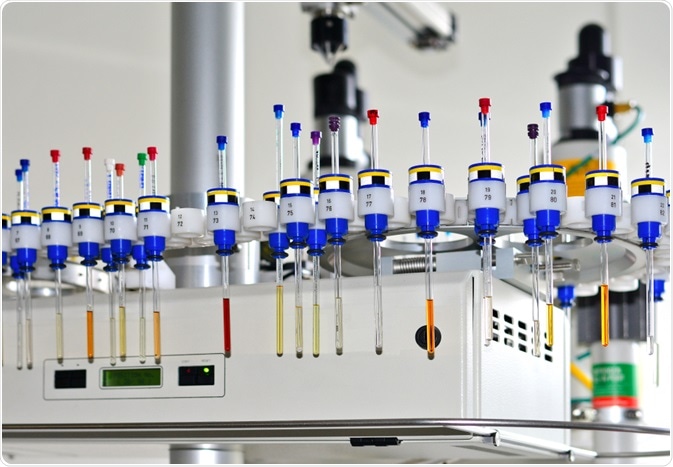NMR is a powerful technique for uncovering the nature of small molecule interactions. This field has gained much interest in recent years, as the field of drug discovery and development has begun to heavily rely on the technique to elucidate ligand-sensing and disease-linked noncoding RNAs occurring naturally in the body that could have potential therapeutic use.

Image Credit: Smereka/Shutterstock.com
What is NMR?
Nuclear Magnetic Resonance (NMR) spectroscopy is a spectroscopic technique used in analytical chemistry to uncover the local magnetic fields around the atomic nuclei of a sample. This information can reveal the sample’s chemical composition and purity.
The technique involves establishing a magnetic field around the sample, generating an NMR signal via the excitation of the sample’s nuclei with radiofrequency waves, creating nuclear magnetic resonance. This is picked up by the sensitive radio receivers.
Atoms have an intramolecular magnetic field surrounding them. This has the impact of changing the resonance frequency.
These changes give insight into the electronic structure of the sample, giving details on its functional groups. Because the intramolecular magnetic fields are fairly unique to individual compounds, these signals can be used to determine the identity of a sample.
They can also be used to help biochemists identify proteins and other complex organic molecules.
Using NMR in the study of small-molecule interactions
NMR has several applications, particularly in research due to its ability to determine the identity of substances, as well as assessing its purity and defining its molecular structure. One area that has greatly benefited from exploiting the characteristics of this technique is drug research and development.
Many significant discoveries have been made via the use of NMR in drug discovery studies, and the number continues to grow. This has emerged out of using NMR to understand small molecule interactions to reveal naturally occurring ligand-sensing and disease-linked noncoding RNAs that may help develop new therapeutic compounds.
NMR has been used, since the 1970s, within the pharmaceutical industry to carry out studies into drug discovery.
Today, the number of papers using NMR in drug studies continues to increase, as the method becomes more popular, and more successes in the drug discovery field are gained as a result of running these kinds of tests.
A classical example of NMR application is the discovery of certain inhibitor and analysis of its binding mode, and a noteworthy one is the detection of allosteric regulator via NMR-based screening and its conformational analysis.
NMR has grown in popularity because of several advantages it has over other techniques. To begin with, NMR signals are produced both by chemical compounds and biomolecules. Also, the binding mode between them (for example, the tertiary structures, interaction interface, and conformational changes) can be determined at the atomic resolution. Finally, NMR can detect weak intermolecular interactions due to its high sensitivity.
NMR can be used in two ways in drug discovery research. The first is ligand-based. This is where proteins are detected via the ligands that they are bound to.
The approach which does not require isotope labeling is fast and produces sensitive NMR measurements. The method is also less impacted by contaminants and impurities but only on the condition that they do not intervene with the function and stability of the target protein and fragment.
However, there are limitations to the ligand-based approach. For example, it is difficult to apply to strong binders unless an advanced NMR technique is used. Also, because ligand signals cannot be used to determine the protein-bound form, the detection of target protein-ligand binding can be problematic.
The second method is the protein-based approach. Here, the heteronuclear single quantum correlation (HSQC) spectra of 1H-15N and 1H-13C are measured for uniformly 15N- and 13C-labeled proteins respectively. This process occurs in the absence or presence of ligands.
To identify the target protein’s ligand-binding site, researchers look at the HSQC chemical shift perturbation and the ligand binding-induced signal broadening.
Even extremely low-affinity interactions can be detected with this approach, which is one of its benefits of use. In addition, it is simple to run, and preparations are inexpensive. Structural changes and ligand binding are easily monitored, which makes it a good approach for protein fingerprinting.
Structure-based drug discovery has greatly benefited from both these approaches, where the ligand-based approach has proved valuable in the screening of hit ligands, and the protein-based approach has proved useful in the process of hit validation and selecting hit ligands from both false-positive and non-specific binders.
NMR will likely continue to be used in drug discovery research. Already the number of pharmaceutical studies using NMR is growing, with numerous significant advancements being made in therapeutic development thanks to its use.
The future will likely see more NMR studies helping to push forward the pharmaceutical advances.
Sources:
- Moore, J. (1999). NMR screening in drug discovery. Current Opinion in Biotechnology, 10(1), pp.54-58. www.sciencedirect.com/science/article/abs/pii/S095816699980010X
- Pellecchia, M., Bertini, I., Cowburn, D., Dalvit, C., Giralt, E., Jahnke, W., James, T., Homans, S., Kessler, H., Luchinat, C., Meyer, B., Oschkinat, H., Peng, J., Schwalbe, H. and Siegal, G. (2008). Perspectives on NMR in drug discovery: a technique comes of age. Nature Reviews Drug Discovery, 7(9), pp.738-745. https://www.ncbi.nlm.nih.gov/pmc/articles/PMC2891904/
- Sugiki, T., Furuita, K., Fujiwara, T. and Kojima, C. (2018). Current NMR Techniques for Structure-Based Drug Discovery. Molecules, 23(1), p.148. https://www.ncbi.nlm.nih.gov/pmc/articles/PMC6017608/
- Thompson, R., Baisden, J. and Zhang, Q. (2019). NMR characterization of RNA small molecule interactions. Methods, 167, pp.66-77. https://www.sciencedirect.com/science/article/pii/S1046202318303888
Last Updated: Mar 20, 2020